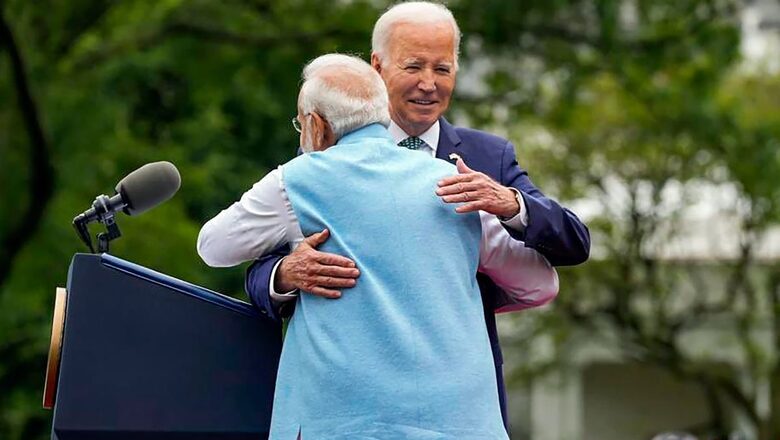
views
Prime Minister Narendra Modi and US President Joe Biden’s ‘jugalbandi’ in Washington has inaugurated a new age of America-India relations. As the prime minister put it during his address to the joint session of the US Congress: “In the past few years, there have been many advances in AI — Artificial Intelligence. At the same time, there have been more momentous developments in another AI — America and India.”
Going beyond the semantics, which got a standing ovation from US lawmakers, this evocative phrasing reflected the seismic nature of the shift underfoot in India-US relations that this visit bookends.
The visit heralds an epochal shift in the relationship between the world’s largest democracy and its most powerful one at multiple levels. The sweeping ambition of the strategic partnership — from technology to defence to a wider strategic convergence — is unprecedented in the bilateral relationship between Delhi and Washington.
1. Tech cooperation was once a small sidenote in the India-US relationship. It is now at the forefront. Ranging from quantum computing to AI to cybersecurity to outer space, this new focus on a strategic partnership on high tech and commerce has the potential to completely transform the relationship with wider implications for the global tech architecture.
At just the moment when China-oriented global supply chains are being reconfigured, this new focus on technology cooperation between India and US has huge implications.
It is not an accident that the India-US joint statement released after the meeting between Prime Minister Modi and Biden started with a section on “Charting a Technology Partnership for the Future.” Reflecting the new emphasis, the statement mentioned the words ‘technology’ or ‘technologies’ as many as 43 times.
For perspective, when Modi and Biden had met for their first-ever bilateral meeting at the White House in September 2021, the joint statement released at that time mentioned ‘technology’ or ‘technologies’ only 14 times. The 3X difference in the ‘tech’ word cloud over the past two years is a measure of just how much the nature of the relationship has shifted since.
From India’s digital public infrastructure to joint work on space and telecom, technology cooperation is now well and truly at the centre of the India-US relationship.
For sure, India and US have a sporadic history of tech cooperation, going back to the creation of the Indian nuclear and space programme in the 1950s and 1960s, right up to the Green Revolution and the first Indian experiments with satellite TV, through the Satellite Instructional Television Experiment (SITE) programme in the 1970s.
But the decades since have been a story of lost opportunities. They have been characterised by the rise of Indian IT talent that was welcomed in the United States and played such a significant role in powering Silicon Valley — as the number of Indian-origin American tech CEOs reflects. The new focus in the Indo-US tech relationship has the potential to change the global tech order.
2. Integrating into global supply chains: The focus on semi-conductors — as evidenced by agreements with Micron Technology to invest up to $825 million to build a new semiconductor assembly and test facility in India with support from the Indian government, Lam Research’s proposal to train 60,000 Indian engineers through its Semiverse Solution virtual fabrication platform and an announcement by Applied Materials, Inc., to invest $400 million to establish a collaborative engineering center in India — reflects a turning point for India’s semiconductor vision and its vision of integrating in global manufacturing and supply chains for hi-end tech.
3. India and the US Military Industrial Complex: There is a congruence in the spirit behind decisions on the tech track and those taken on the defence track for the manufacture of GE F-414 jet engines in India for the Light Combat Aircraft and the procurement of MQ-9B UAVs, which will be assembled in India, for the Indian armed forces. While questions remain on the nature of technology transfer, these agreements mark a significant crossing of the Rubicon.
Twenty years ago, there were no US defences sales to India at all. As one US official was quoted as saying, “We are now talking about co-producing and co-developing major systems together.”
We are seeing the beginning of India entering the US military-industrial complex. Apart from the defence imperatives, this will benefit India’s aims of enhancing its manufacturing base.
4. India-US and the Asian Balance of Power: In strategic terms, the visit crystallises the congruence between India and the United States for a multipolar balance of power in Asia. While China was not spoken about directly — except President Joe Biden’s characterisation of Chinese President Xi as a ‘dictator’ in separate comments during the week — Beijing is clearly the elephant in the room.
The ramped strategic partnership between Delhi and Washington has unfolded in the backdrop of continued Chinese intransigence on the Line of Actual Control with India and elsewhere in the region. As the strategic affairs analyst C Raja Mohan has pointed out, “The credit for moving India and the US closer than ever before goes to the assertive policies of Xi Jinping. This is ironic, given the extraordinary Chinese interest in keeping India and the US apart in Asia.”
Finally, the nature of the strategic partnership goes against the received wisdom among many of the traditional strategic affairs bureaucracies in both India and the United States. For the US it is unprecedented to enter into such an ambitious framework with a country that is not a formal ‘ally’. For India, they mark a significant departure from traditional suspicions of Washington that underpinned much of the faith in ‘non-alignment’ for decades.
While both countries will have to do a lot of work to action, there is no question that PM Modi and President Biden have leaned into a new era.















Comments
0 comment